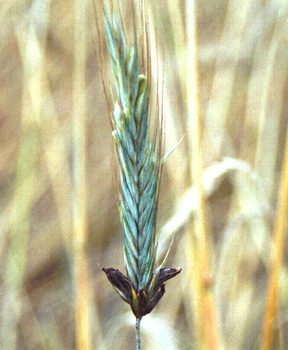Diseases
Claviceps purpurea (Fr.:Fr.) Tul. - Ergot.
Classification.
Class Ascomycota, Order Clavicipitales, Family Clavicipitaceae, Species Claviceps purpurea (Fr.:Fr.) Tul. (Hawksworth et al.,1995)Biological group.
Biotroph.Biology and morphology.
Disease infects rye, wheat, barley, oats and others Poaceae. Before harvest, the dark purple to black sclerotia forms in the head of rye on the place of grains. The sclerotium of C. purpurea is elongated, generally 1-4 times longer than the host seed. It is comprised of a compact mass of fungal tissue encased in the rind. In this state, the fungus survives through the winter in temperate regions. In the spring, at the rye flowering, the sclerotia germinate and product stalked fruiting bodies in which tiny, threadlike ascospores are produced. The ascospores infect rye flowers. The ovary is the only part of the plant susceptible to infection. Fertilized ovaries are resistant to infection. Following infection, the floret exudes a sweet, yellow-white substance called "honeydew." This exudate contains asexual spores (conidia). "Honeydew" attracts more than 40 species of insects to the infected florets. Conidia are picked up by the insects and are transmitted to healthy plants and infect them as long as rye plants are in blossom. There they established in the ovary and at the time of maturity form the sclerotium.Distribution.
In different countries, where rye are cultivated in Europe, Asia, America and Australia. In Russia in all the region where rye are cultivated especially in Northwest and Central regions of nonblack earth zone (Ishkova et al., 2002).Ecology.
The fungus is adapted for regions of humid temperate climate. A period of one-two months of cold (0-10.C) temperatures is required for germination of. The sclerotia are well adapted to overwinter in temperate climate regions. In warmer regions, sclerotia are colonized by other fungi and do not survive well. Rainfall, or high soil moisture, is required for sclerotia germination and production of ascospores. The spores are carried by air currents to rye flowers. Cool temperatures, which delay pollination and subsequent fertilization, increase the period of plant susceptibility.Economic value.
Ergot is not very important in reducing yield. The basic danger is represented with toxins contained in the sclerotia. The foods contaminated with ergot sclerotia may cause a devastating and sometimes deadly syndrome called ergotism in humans and animals. Control measures: Using of healthy seeds. Plough the contaminated land, bury sclerotia deep in the soil (>7 cm) to prevent their development.Related references.
Hawksworth D.L. et al., Dictionary of the fungi., 1995.- 616 p.Ishkova T.I., Berestetskaya L.I., Gasish E.L., Levitin M.M., Vlasov L.Iu. Diagnostics of the main fungus diseases of cereal crops.- SPb:. 2002.- 76 p., (In Russian).
The dictionary-guide of plant pathologist., L.: Kolos, 1967.- 382 p. (In Russian)
© Dmitriev A.P.


